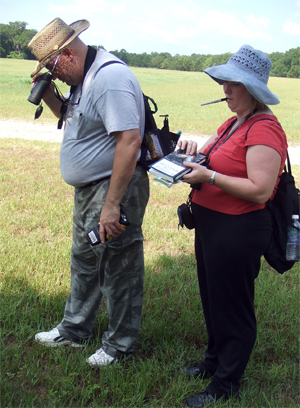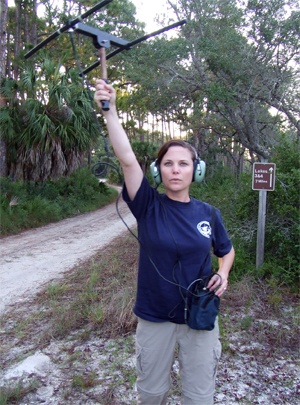Teaching the teachers: FSU professor leads science initiative
A Florida State University researcher with a passion for science education has taken on an ambitious task — supervising dozens of K-12 school science teachers as they gain hands-on research experience in a variety of laboratory and field settings.

This summer, Penny J. Gilmer, a professor of chemistry and biochemistry at FSU, and Steven Blumsack, a retired FSU mathematics professor, are working with 80 science teachers, most from rural and sparsely populated counties in Northwest Florida, to help expose them to the concepts of scientific inquiry in real-world settings. The goal: to get the teachers excited about "doing" science, not just reading about it, so they can spark the same excitement in their students.
"Science Collaboration: Immersion, Inquiry, Innovation," or Sc:iii (pronounced "sigh triple I"), is the name of a project created by the Panhandle Area Education Consortium (www.paec.org) with a $1.5 million grant from the Florida Department of Education. Gilmer has a $340,000 subcontract from the consortium to oversee two FSU graduate-level courses for science teachers.
"For decades, the United States has been slipping further and further behind other developed nations in terms of our knowledge of science and mathematics," Gilmer said. "If we don't find a way to turn this around, it could have profound implications for our country in a number of ways. For example, lack of scientific knowledge hinders our ability to compete economically, threatens our national security and leaves us unprepared to address future health care and technological challenges. Sc:iii is an attempt to create an educational model that can be used to re-engage children in the sciences and expand their horizons in terms of career choices."
During the two courses, the science teachers have plenty of traditional reading and writing assignments — but the real challenge comes in the field. Over a six-week period, the teachers perform research at their choice of 40 state parks, national wildlife refuges, laboratories and other sites in an area stretching from Pensacola to the west, Live Oak to the east and Perry to the south. While in the field, they work alongside veteran scientists, park officials and other experts. The teachers also must maintain an online journal of their experiences and reflections.
For Gilmer, Sc:iii has made for a busy summer. She has been on the road virtually every weekday, visiting teachers in the field, encouraging them and observing their progress.
"It's exciting to see those 'Aha!' moments when the teachers really start to understand what scientific inquiry is all about," Gilmer said. "They begin to appreciate that it's a process of observing, gathering data, analyzing that data and discussing it with others to arrive at conclusions. I'm seeing teachers become more energized, more capable and more innovative in their approach to science education, and I believe their students will benefit from the teachers' experiences."
Stacey Frakes is one of those teachers. Her fieldwork has involved assisting the Florida Natural Areas Inventory in performing a survey of butterfly populations at Tallahassee's Elinor Klapp-Phipps Park. The hands-on approach to science is one that she is eager to share with her students at Madison County Central School in Madison, Fla.

"I tend to want to give my students all the answers they need to complete a worksheet or a lab, but I am learning that if I just point them in the right direction, they will be able to do some amazing things," Frakes said. "I am learning to let go and wait patiently for those teachable moments. My ability to teach science has been greatly enhanced by this experience."
Another teacher gaining valuable experience is Laura Quisenberry, who taught science to fifth-graders at W.R. Tolar School in Bristol, Fla., last year. Her Sc:iii studies have taken her to St. Vincent National Wildlife Refuge in Franklin County, where she assisted scientists from the U.S. Fish and Wildlife Service in monitoring wildlife on the pristine barrier island. Quisenberry's work included using GPS to identify and mark nests of loggerhead sea turtle eggs buried along the beach and using telemetry technology to locate and track a breeding colony of red wolves.
"This experience has broadened my understanding of inquiry-based learning in that we have been able to engage in the inquiry process ourselves," she said. "We essentially went into the field with an open mind and without the expectation of a certain outcome from our research. An understanding of this process is what I plan to take to my classroom. I hope to teach my students that outcomes may not always be as predicted."
Gilmer said that the initial focus of the Sc:iii initiative has been on helping science teachers who need it the most — teachers from small, poorer counties of Northwest Florida that don't have a lot of resources to show students how critical science is to their everyday lives.
The teachers' experiences and reflections of the program will be included in a monograph edited by Gilmer and a colleague, Kate Calvin. In addition, PAEC is filming a one-hour documentary of the program to capture the events taking place this year, the first in which this breadth of grade levels and geographical locations are represented.
For more information about Sc:iii, visit www.paec-sc-iii.org.